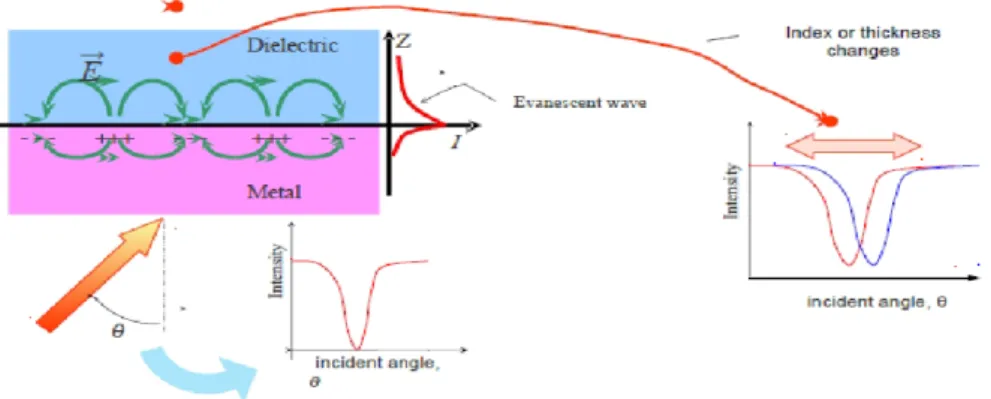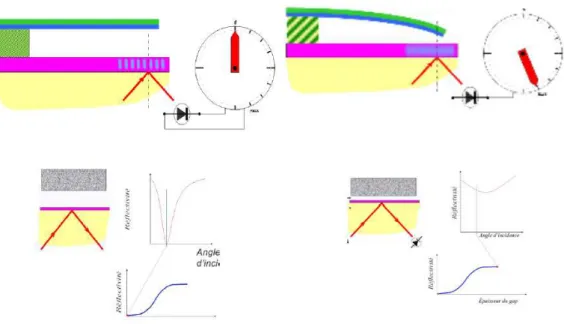Study of a possible X-ray sensor
based on the Plasmon Surface Resonance
for the next generation of instruments
Anthony Herv´e
1, Juriy Hastanin
2, Serge Habraken
3& Gregor Rauw
11 GAPHE, AGO, Universit´e de Li`ege, All´ee du 6 Aoˆut 17, Bˆat. B5c, 4000 Li`ege, Belgium 2 CSL, avenue Pr´e-Aily , Bˆat. B29, 4031 Angleur 4000 Li`ege, Belgium
3Hololab, Universit´e de Li`ege, All´ee du 6 Aoˆut 17, Bˆat. B5a, 4000 Li`ege, Belgium
Abstract: With the new generation of X-ray space observatories, such as IXO in preparation, we explore a new technology in order to improve the spectral resolution and the sensitivity of future instruments. We have studied the possibility to create a sensor based on the Surface Plasmon Resonance (SPR), already used in chemistry and biomedical applications, and have determined the preliminary constraints on its size, energy resolution and working temperature.
1
Introduction
Even though XMM-Newton and Chandra have deeply modified our view of the X-ray universe, they have also triggered new questions that call for a high sensitivity X-ray observatory offering high en-ergy resolution. Well exposed, higher resolution spectra are indeed needed to confront theoretical models with observations. In this context, we present a new candidate technology for space instru-mentation which is currently already used in biomedical and chemistry applications. The Surface Plasmon Resonance (SPR) could be an alternative to calorimeters and other traditional instruments for future X-ray integral field spectrographs.
2
Theory
Surface plasmons are quantized oscillations of free electrons at the interface between a metal (gold, silver or other) and a dielectric material (air for example). In sensing applications, the surface mons are commonly excited by evanescent electromagnetic waves at optical frequency. Surface plas-mons are excited at a specific incidence angle and result in a sharp and significant reduction of re-flected light intensity at this angle (Fig.1). This phenomenon is referred to as ”Surface Plasmon Resonance” (SPR). The surface plasmon resonance angle can be calculated via the dispersion re-lation obtained from Maxwell’s equations and the continuity conditions at the interface boundaries (Kretschmann & Raether 1968, Otto 1968).
“The multi-wavelength view of hot, massive stars”; 39thLi`ege Int. Astroph. Coll., 12-16 July 2010
Figure 1: Scheme of the Surface Plasmon Resonance effect.
3
An example of an SPR sensor and first results of a preliminary
feasibility study
The concept of the detector is very simple (Fig.2, Hastanin 2009). The cantilever consists of an X-ray absorber fixed on a second non-absorbing material with a different Young module. When a photon is absorbed, the temperature of the absorber increases and leads to a deformation (lengthening) of this part of the cantilever. However, the temperature of the second component of the cantilever is constant. So, the cantilever bends in the direction of the gold layer fixed on the prism surface. The gap of air decreases, modifying the properties of the plasmon surface and accordingly the reflectivity of the prism. The intensity of the reflected light of the laser at the gold/prism interface thus also decreases. From the knowledge of the variation of the intensity of the reflected laser light and the properties of the sensor, we can deduce the energy of the absorbed photon.
In practice, we are confronted to different issues. The main constraint on the future sensor is the working temperature. The thermal noise in the material creates oscillations of the cantilever which lead to fluctuations of the intensity of the reflected laser light. To limit this agitation we have to work at very low temperature to make sure that the variation of the intensity of the laser is truly the result of the absorption of an incoming photon. For example, if we want an accuracy of 1 eV for the sensor we need to work below 1 K.
Assuming the possibility to work at this very low temperature, we now focus on the size of the sensor. In fact, with the future instruments, astronomers want to observe X-rays in the 0.1-10 keV domain with an accuracy of 1eV. The readout system (variation of the intensity of the laser) is very sensitive; a decrease of a few percent in the intensity of the laser is detectable, this corresponds to a motion of the cantiler of a few nanometers. We thus have to adapt the motion of this latter to the accuracy of the detection of a variation on the intensity of the laser. The difference of the bending of the cantilever between two photons the energies of which differ by 1 eV should be around a few nanometers in order for the change of the laser intensity to be detectable. This is our second issue. At room temperature, it is rather easy to find atomic data, and physical properties of the material. However, since we have to work under cryogenic conditions, this is more challenging. The physical behaviour of some of the materials at very low temperature is poorly known and regarding the difficulties to develop experimental studies, we are confronted with a lack of information concerning the absorption capacity, Young module and other properties of the materials. Nevertheless, we have used an extrapolation of the physical laws to low temperatures to estimate the characteristics we need for some materials. Thus, if we use a layer in silicon or bismuth for the absorber, we find that the size of the sensor and especially the cantilever, is compatible with standard micro-manufacturing technology.
501
Figure 2: Illustration of an SPR sensor, with the different components. Left: At rest. Rigth: After the absorption of a photon.
To obtain an SPR effect, the size of the gap between the cantilever and the gold surface is limited (around a few hundred nanometers). In consequence, we need to adjust the dynamical motion of the cantilever and the energy band that we want to observe. Our first results indicate that it is very difficult to measure the full 0.1-10 keV band with an accuracy of 1eV. The design of the detector presented in Figure 2 allows the detection of photons in the 0.1-6 keV band with an accuracy of 1 eV. We are currently working on the design of the sensor to increase the observable energy band. But, our theoretical solution faces manufacturing difficulties. And more important we need to study the impact of the Van der Walls interaction between the cantilever and the gold surface.
The SPR technology has many assets (Hastanin 2009). The measurement of the energy of the absorbed photon is very sensitive. The readout of the global sensor only depends on the capacity to evacuate the heat in the cantilever since the readout of the intensity of the reflected laser light is instantaneous. These features yield an excellent efficiency in the counting of photons. Futhermore, the whole energy of the photons is converted into a mechanical motion of the cantilever and there is no loss in an intermediate system between the absorber and the readout system.
4
Conclusion
A new X-ray sensor based on the SPR technology can be an alternative to other technologies. The readout is very fast and the sensitivity of the measurement is excellent. This yields a very robust behaviour with respect to photon pile-up and a very good accuracy in the measurement of the energy deposited by the photon. The concept which we propose reduces the thermal loss contrary to the other calorimeters. The limitation of this technology is essentially due, as for most other instruments, to the thermal noise. The size and the design of the future detector should allow to design an integral field X-ray spectrograph with good spatial resolution.
502
Acknowledgements
This research is supported by the FNRS (Belgium) and by the Communaut´e Franc¸aise de Belgique -Action de recherche concert´ee (ARC) - Acad´emie Wallonie–Europe.
References
E. Kretschmann, H. Raether, 1968, Z. Naturforsch., 23A, 2135 A. Otto, 1968, Z. Physik, 216, 398
J. Hastanin, 2009, PhD thesis, Universit´e de Li`ege
503

